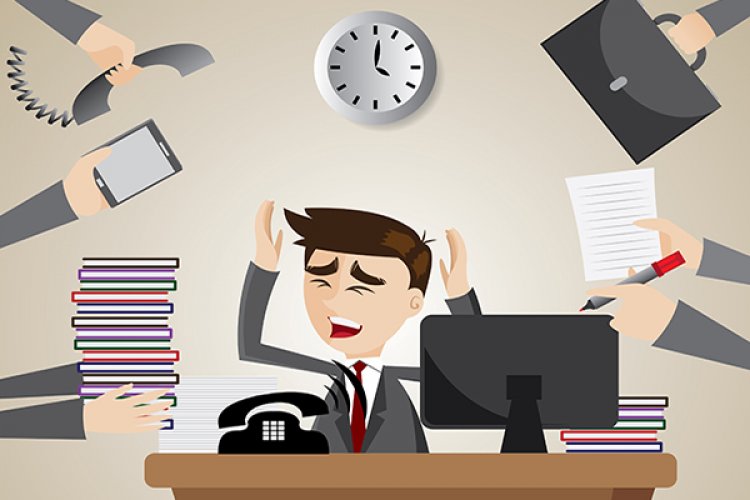How’s the C-suite treating you today…are you ready for stress relief?
Sharon M. Weinstein, Author, B is for Balance, 12 Steps toward a More Balanced Life at Work and at Home

The chief
So you are the chief – Chief Executive Officer, Chief Operating Officer, Chief Financial Officer or Chief Information Officer! What is that “C” contributing to your stress levels, and what are you willing to do to relieve the stress? Do you really think that stress doesn’t have an impact on your body, your memory, your ability to function as a chief, and your outlook on life?
The numbers tell it all
- The Centers for Disease Control and Prevention estimates that 60 to 70 percent of all disease and illness is stress-related.
- An estimated 75 to 90 percent of visits to physicians are stress related.
- According to a study in the Journal of the American Medical Women's Association, 60 percent of women surveyed said work stress was their biggest problem.
- Job pressures cause more health complaints than any other stressor, says the National Institute for Occupational Safety and Health.
Your outlook
I can guess what you’re thinking… here’s one more thing I have to worry about. As a senior executive, you need to worry! You can’t – nor do you ever want to – eliminate stress altogether. Some stress is beneficial. I’ll even go out on a limb and say that stress by itself is never actually harmful or bad. It’s your reaction to stress that creates problems. It’s your outlook that counts!
We’re simply trained to ignore the signs of stress in an attempt to keep the problems at bay. No wonder: changing life-long behaviors is in itself stressful. This is a classic mind-body disconnect.
The three phases of stress
As you know, just being in business today creates stress, and at your level, stress is more prevalent. Here’s how most people react to a stressor (such as: earnings announcement, problems at home, manufacturing flaws, countless mind-numbing meetings):
- First, in what is called the “alarm phase,” they react to the stressor. This might result in a burst of anger, shock, or surprise.
- Second, they move into the “resistance phase,” when they begin to adapt to the stressor. They learn to cope with the dysfunction, lack of sleep, or 16-hour work days. This phase can last for years, and after a while will feel very “normal.”
- Third, the body finally loses steam. They go into the “exhaustion phase,” where their ability to resist is reduced. They’ll feel tired, unable to concentrate, and will often catch colds or become ill – the body’s way of slowing them down.
I know from experience that there are many ways to more effectively handle the everyday stressors, as well as those big once-in-a-while stressors. I’ve taught meditation, mindfulness training, breathing exercises, and disseminated countless bits of information on general nutrition and the benefits of regular exercise. Perhaps, as the C-suite executive, it is time for you to learn how to relax!
Squeeze a few minutes of relaxation into each day
Far too many of us lead lives that are frenzied and hurried from the moment we wake up in the morning to the moment we crawl into bed at night. The more packed every moment of your day is the more you need to make time to relax; for a few minutes of deep breathing to 20 minutes of deep relaxation or yoga. Making this a habit will keep you in better stress shape for the day that chronic stress knocks on your door, which it almost certainly will (if it hasn’t already). After all, in your senior position, the problems land at your door.
The human system can tolerate a tremendous amount of stress. Over the years, however, too much stress breaks down your resistance to illness and disease and impacts your memory. Remember, the negative consequences of your stress are strongly influenced by your rest habits. Since stress is unlikely to diminish in our high-pressured American lifestyle, take the time throughout your day for the natural unwinding of your stress response.
There are only 24 hours in each day
You don’t have time to rest, you say? You have more time than you think you do. You could:
• Do deep breathing while driving to work and during other stressful moments throughout your day.
• Get up 15 minutes earlier and spend the time doing deep relaxation, yoga or journaling.
• Take 2 minutes several times a day to tense tight muscle groups for 10 to 15 seconds, and then relax them completely. Repeat this two to three times each round.
So you are the chief
How is the C-Suite treating you today? There is no better time to consider the actions that you will take to enhance your role and to preserve your ability to function as a Chief.
About the Author
Sharon M. Weinstein is the author of B is for Balance: 12 Steps Toward a More Balanced Life at Home and at Work, Sharon M. Weinstein is an energetic, motivating and highly skilled speaker who educates others, enriches their lives, and empowers them to achieve balance in their own lives. Sharon draws on her own life experiences to help others gain control of their life purpose. Sharon is Adjunct Clinical Professor at the University of Illinois Chicago, College of Nursing and a member of the Kaplan University School of Nursing Advisory Board. She is a Fellow of the American College of Wellness and the American Academy of Nursing. Sharon is a member of the National Speakers Association, and she’s available to address stress management with your C-Suite executives!

















